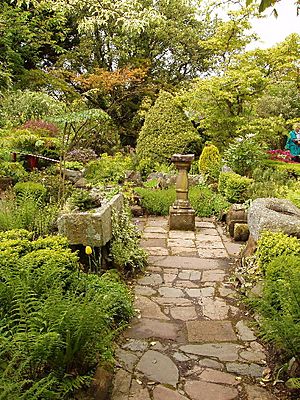Broughton House facts for kids
 |
|
| Established | 1734 |
|---|---|
| Location | Kirkcudbright, scotland |
Broughton House is a beautiful old house from the 1700s. It stands on the High Street in Kirkcudbright, Scotland. This house was once the home of a famous Scottish artist named Edward Atkinson Hornel. He lived here from 1901 until he passed away in 1933.
During his time, Hornel made many changes to the house. He also created amazing gardens with a Japanese style. Since 1997, the National Trust for Scotland has looked after Broughton House. They keep it as a "living museum" to show everyone Hornel's life and his artwork. The house is a very important historical building. Its gardens are also special and listed in Scotland's important landscapes.
Contents
History of Broughton House
Early Days of the House
The main building of Broughton House was first built in 1734. It actually started as two separate houses at numbers 10 and 12 High Street. In 1740, a man named Alexander Murray bought both houses. He was a important person in Kirkcudbright and a Member of Parliament. Murray had the two houses joined together to make one big home.
The Murray family sold the house in 1756. After that, many different people owned it. One of the owners was the 5th Earl of Selkirk.
E. A. Hornel's Home
Edward Atkinson Hornel (1864–1933) grew up in Kirkcudbright. He became a well-known artist, part of a group called the Glasgow Boys. In the 1890s, Hornel traveled all the way to Japan. He spent over a year there, creating about 30 paintings. When he returned in 1895, he showed these paintings in Glasgow.
The money he earned from selling these Japanese paintings helped him buy Broughton House in 1901. He paid £650 for it, which was a lot of money back then! Hornel lived in Broughton House with his sister, Elizabeth, who everyone called 'Tizzy'. He lived there for the rest of his life.
Hornel asked his friend, the architect John Keppie, to add a special art studio to the house. Later, in 1910, Keppie also designed a gallery for Hornel's art. Hornel was a very successful artist. He continued to travel, especially in the Far East. He also collected many rare books.
After Hornel died in 1933, his sister Elizabeth continued to live in the house until 1950. Then, a group called The Broughton House Trust managed the property. Later, it was given to the National Trust for Scotland. In his will, Hornel wanted his house to be "preserved as a public art gallery." He wanted it to benefit the people of the Stewartry and visitors.
Exploring the House and Gardens
Inside Broughton House
The National Trust for Scotland takes care of Broughton House. They keep it just as it was when Hornel lived there. It's like a museum showing his life and work. Inside the house, you can see furniture from that time. There are also many artworks by Hornel and other artists he knew.
The house has a huge library with about 15,000 books. Hornel collected these books himself. This includes a collection of 2,500 books by or about Robert Burns, a famous Scottish poet. This is one of the biggest Burns collections in the world! The library also holds Hornel's personal notes, letters, and newspaper clippings. You can also see his art studio, set up as if he just stepped away from his work. In the gallery, there's a special design that looks like the famous Elgin Marbles from the Parthenon in Greece.
The Beautiful Gardens
The gardens at Broughton House are behind the house and go down to the River Dee. Hornel and his sister designed these gardens, which cover about 2 acres. Part of the garden is a Japanese garden. It has a rockery and a pond with stepping stones. Closer to the river, there are garden beds separated by neat box hedges. You can also find several old sundials from the 1600s and 1700s in the garden. There are also carved stone gate posts from the late 1600s.



